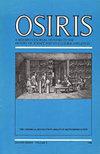科学革命中的科学和经济:概念、材料和可通约的碎片
IF 1
3区 哲学
Q2 HISTORY & PHILOSOPHY OF SCIENCE
引用次数: 0
摘要
关于所谓科学革命性质的争论可以被视为描述科学史领域许多根本变化的试金石。科学史和科学哲学在20世纪下半叶的建立,正值胜利的西方盟友中的顶尖学术科学家致力于将科学与直接的政治和经济纠葛分开的时候。与20世纪30年代受马克思主义启发的科学家不同,他们试图将科学思想提升到人类精神的最高表达水平,与莎士比亚等人站在一起。因此,“纯粹”科学思想的历史推动了这一领域的发展。到20世纪70年代,对意识形态、社会关系和实践的关注开始开辟其他分析可能性。但其他分析方法开始寻找方法来理解身心是相连的,而不是分开的。科学家们所关注的实物可以像硬币一样跨越许多边界,这表明科学过程并不局限于人类历史的一个分支或世界的一个地区。科学的经济规模远远大于道德经济。本文章由计算机程序翻译,如有差异,请以英文原文为准。
Sciences and Economies in the Scientific Revolution: Concepts, Materials, and Commensurable Fragments
Debates about the nature of the so-called Scientific Revolution can be treated as a touchstone describing many of the fundamental changes in the field of the history of science. The establishment of the history and philosophy of science in the second half of the twentieth century occurred at a time when leading academic scientists among the victorious Western allies were intent on keeping the sciences apart from direct political and economic entanglements. In contradistinction to the Marxist-inspired scientists of the 1930s, they sought to raise scientific ideas to the rank of the highest expression of the human spirit, standing alongside Shakespeare and the like. A history of “pure” scientific ideas therefore motivated the field. By the 1970s, attention to ideologies, social relations, and practices began to open up other analytical possibilities. But other analytical approaches began to look for ways to understand mind and body as joined rather than as separate. The material objects to which scientists attend can be made commensurable, flowing like coins across many borders, suggesting that scientific processes are not confined to one branch of human history or one region of the world. The sciences have economies that are larger than moral economies alone.
求助全文
通过发布文献求助,成功后即可免费获取论文全文。
去求助
来源期刊

Osiris
管理科学-科学史与科学哲学
CiteScore
1.10
自引率
0.00%
发文量
18
审稿时长
>12 weeks
期刊介绍:
Founded in 1936 by George Sarton, and relaunched by the History of Science Society in 1985, Osiris is an annual thematic journal that highlights research on significant themes in the history of science. Recent volumes have included Scientific Masculinities, History of Science and the Emotions, and Data Histories.
 求助内容:
求助内容: 应助结果提醒方式:
应助结果提醒方式:


